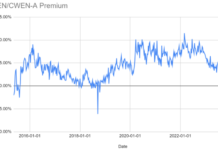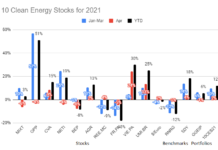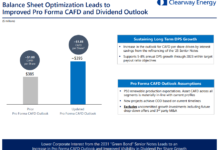Tom Konrad CFA

Capstone Infrastructure Corp.’s Gas Cogeneration facility in Cardinal, Ontario.
Capstone Infrastructure Corporation (TSX:CSE, OTC:MCQPF. Disclosure: I own this stock) is an international operator and developer of green infrastructure assets and utilities which is currently selling at a significant discount to most comparable firms. I recently ran a comparison of six similar Canada-listed firms, and Capstone seemed much cheaper on several measures.
The Discount
The following chart compares five renewable energy and green infrastructure firms with most of their operations in Canada: Capstone, Algonquin Power and Utilities (TSX:AQN, OTC:AQUNF), Brookfield Renewable Energy Partners (NYSE:BEP), Northland Power (TSX:NPI, OTC:NPIFF), and Innergex Renewable Energy (TSX:INE, OTC:INGXF). (I own all these stocks.)

As you can see from the chart, Capstone has not only the highest dividend yield, but also scores better on factors which reflect on its ability to maintain that dividend. In particular, Capstone has much higher revenue and income relative to its market capitalization than the other companies.
 That said, neither revenue nor income is a very good measure of a company’s ability to maintain its dividend for this sort of infrastructure company. Revenue is not a good indicator of the ability to maintain a dividend when a company has too much debt or preferred equity, or the business is not profitable. As you can see from the chart to the right, Capstone’s common equity is in line with or stronger than the other firms in the comparison.
That said, neither revenue nor income is a very good measure of a company’s ability to maintain its dividend for this sort of infrastructure company. Revenue is not a good indicator of the ability to maintain a dividend when a company has too much debt or preferred equity, or the business is not profitable. As you can see from the chart to the right, Capstone’s common equity is in line with or stronger than the other firms in the comparison.
For capital-heavy infrastructure firms, income may understate the ability of a firm to pay dividends because of large non-cash depreciation and amortization charges. Two of the firms compared (Algonquin Power and Infrastructure and Brookfield Renewable Energy Partners) actually had negative income over the previous twelve months. Most such firms publish a measure of Adjusted Funds From Operations (AFFO) to give investors insight into their ability to pay dividends. Unfortunately, these measures are not defined by standard accounting rules, and so they can be problematic to compare across firms.
Rather than use published AFFO numbers, I chose instead to adjust for amortization and depreciation directly to get EBDA (Earnings Before Depreciation and Amortization), by adding them back in to income. This has some of its own problems, in that it involves double counting the tax deductions on depreciation and amortization and it leaves out some other potentially relevant adjustments, but at least it is comparable between firms. The yellow bars in the first chart (titled “Green Canadian Infrastructure Firms”) confirm that Capstone’s EBDA is also in-line with the other firms in the comparison.
Given Capstone’s high dividend and apparent ability to continue paying that dividend based on these accounting measures, I have to conclude the firm is trading at a discount.
Cardinal
Since Capstone seems to be trading at a discount to similar firms, it’s quite reasonable to ask why. A quick review of management’s most recent discussion and analysis in its quarterly and annual filings makes the answer clear: Capstone’s largest asset, the 156 MW Cardinal gas cogeneration plant in Ontario (pictured in the lead photo) has an expiring Power Purchase Agreement. This agreement covers the sale of the generated electricity to the Ontario Electricity Financial Corporation, and it expires in 2014. The steam and compressed air generated by Cardinal is sold at contracted rates to an Ingredion (NYSE:INGR) Canada Inc. (formerly Casco Inc.) facility, one of the largest corn refining facilities in Canada, located adjacent to the Cardinal plant. The agreements with Ingredion expire in 2016.
Capstone has been in discussions with the Ontario Power Authority over a new contract, but have not yet reached an agreement “that recognizes Cardinal’s value and its industrial, economic, social and community importance.”
Shareholder concern over the lack of a new contract has clearly been hurting the stock price. Management is clearly aware of this, and says “Securing a new contract for Cardinal [is] our top priority for 2013.”
In 2012, electricity sales from Cardinal amounted to approximately 31% of revenue. However, Capstone is in the process of buying Renewable Energy Developers (TSX:RDZ, OTC:STWPF). After the merger, Cardinal’s share of revenue should drop below 29% for the combined entity, and will be even lower going forward, because RDZ brings with it a development pipeline which should increase Capstones future growth.
Is it really that bad?
With the market for 29% of Capstone’s revenue up in the air, it makes sense for Capstone to be trading at a discount relative to its peers. But how much of a discount?
- Based on its dividend yield of 7.8%, Capstone is trading at a 21% discount compared to similar firms, which pay on average 6.2%. So investors are pricing in a 21% decrease in Capstone’s ability to pay dividends, which equates a 72% reduction in Cardinal’s profitability.
- Based on Revenue, Capstone could lose all sales from Cardinal and still be trading at a lower multiple of sales than the comparable firms.
- Based on a price to book ratio (P/B) of 0.7, it should be able to write off the entire value of Cardinal and still have Capstone trade in the P/B range of its peers (1.3 to 2.1, with an average of 1.6,) even if it accounts for up to two-thirds of Capstone’s equity.
- Based on reported AFFO, Capstone’s dividend payout ratio was only 50% of AFFO in the first six months of 2013, while the company targets a long term payout ratio of 70% to 80% of AFFO. Hence, AFFO could fall by one third and Capstone would be able to maintain its dividend while meeting its target payout ratio.
While the market of electricity in Ontario is not growing rapidly, economic factors make me believe that Cardinal should be able to operate at a
profit even without a PPA. In particular, growing demand in connecting regions (Manitoba, Quebec, New York, Michigan, and Minnesota) should provide a floor for electricity prices. As long as natural gas prices remain low, Cardinal should be able to sell its power at attractive prices, especially since some of its costs will be covered by sales of heat and compressed air to Ingredion. Finally, with most of Ontario’s power coming from inflexible baseload nuclear and coal plants, the increasing penetration of renewables under Ontario’s Feed in Tariff makes Cardinal’s flexible gas cogeneration an increasingly valuable part of Ontario’s generation mix.
In any case, Capstone’s discussions with the Ontario Power Authority are more about “plans to reconfigure and expand the facility, rather than on extending the existing power purchase agreement (PPA)” according to the most recent quarterly report. The negotiations in Ontario seem as likely to provide an upside opportunity as to reduce the firm’s future prospects.
Conclusion
With the uncertainty around the renewal of the Cardinal PPA, Capstone is trading at a substantial discount to its peers. But that uncertainty has both upside and downside, while the market seems to be pricing in only a catastrophic downside. With a 7.8% yield based on a C$0.30 dividend which was already reduced (in June 2012) to reflect the uncertainty around the PPA negotiations, Capstone should be very attractive to income investors.
If the results of the negotiations are unfavorable, Capstone should be able to maintain its current dividend. If they can continue business as usual or achieve a framework which allows them to invest in and expand Cardinal, there is substantial scope for dividend increases going forward.
In either scenario, the increased certainty and constant or increasing dividend should lead to stock price appreciation on top of an attractive dividend over the next couple of years. If the PPA is renewed on terms which allow the dividend to be maintained at C$0.30, and the yield falls to the 6.15% average of Capstone’s peers, then Capstones stock price would have to rise to C$4.88, 30% higher than the current C$3.76.
This article was first published on the author’s Forbes.com blog, Green Stocks on Sepetmber 11th.
Disclosue: Long CSE, AQN,NPI,BEP,INE,RDZ
DISCLAIMER: Past performance is not a guarantee or a reliable indicator of future results. This article contains the current opinions of the author and such opinions are subject to change without notice. This article has been distributed for informational purposes only. Forecasts, estimates, and certain information contained herein should not be considered as investment advice or a recommendation of any particular security, strategy or investment product. Information contained herein has been obtained from sources believed to be reliable, but not guaranteed.








